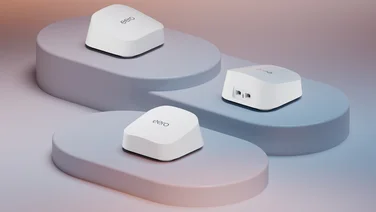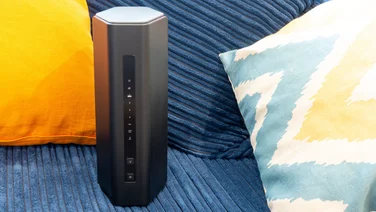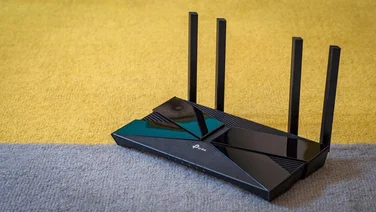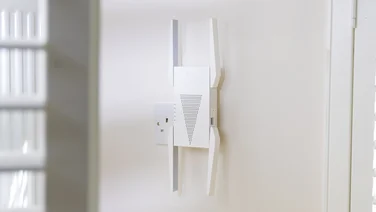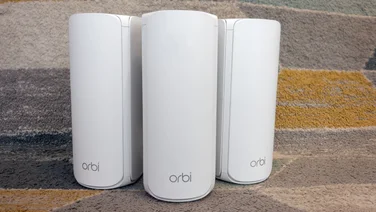To help us provide you with free impartial advice, we may earn a commission if you buy through links on our site. Learn more
- TP-Link Deco Voice X20 review: What you need to know
- TP-Link Deco Voice X20 review: Price and competition
- TP-Link Deco Voice X20 review: The hardware
- TP-Link Deco Voice X20 review: Setup and software
- TP-Link Deco Voice X20 review: Voice assistant
- TP-Link Deco Voice X20 review: Performance
- TP-Link Deco Voice X20 review: Verdict

- Very easy to set up and use
- Effective whole-home Wi-Fi coverage
- Eye-catching yet space-efficient
- Middling Wi-Fi performance
- Mediocre sound quality
- Working out where best to locate the two units might be a puzzle
We rather liked the original TP-Link Deco X20, an unfussy, reasonably priced mesh system capable of extending a strong Wi-Fi 6 signal throughout a medium-sized property. Now, TP-Link introduces the Deco Voice X20, which takes the same wireless hardware and adds full smart speaker capabilities, courtesy of Amazon’s Alexa platform.
If your home is starting to get overloaded with gadgets, there’s a lot to like about the idea of integrating these two functions into a single unit. Indeed, the Deco Voice X20 took an iF Design Award earlier this year, having previously been honoured in the 2021 CES Innovation Awards.
The question, however, is how well it works in practice – and whether it’s worth the comparatively steep price of £280 for a two-node pack.
TP-Link Deco Voice X20 review: What you need to know
The Deco Voice X20 is a Wi-Fi 6 (802.11ax) mesh system with claimed connection speeds of up to 1,201Mbits/sec on the 5GHz band and 574Mbits/sec over 2.4GHz channels. The transmitters support multi-user 2×2 MIMO, to help share the connection between multiple clients but, as with the regular X20, it’s only a dual-band design, so backhaul traffic will inevitably eat into the available bandwidth. You’ll also see lower speeds if you connect from an older device using the Wi-Fi 5 (802.11ac) standard.
What’s special about the Voice X20 is the presence of a far-field microphone array on the top of each unit, and a speaker at the bottom. These allow all X20 units to do double duty as Amazon Echo smart speakers: once registered to your Amazon account, they can handle music streaming, smart home controls and shopping, along with all sorts of other capabilities via third-party skills.
TP-Link Deco Voice X20 review: Price and competition
I tested the two-node Deco Voice X20 system, which costs £280; TP-Link also offers a four-pack, which right now costs precisely twice as much. Oddly, there’s no triple-pack option, nor is it possible to buy extra nodes individually. You can, however, extend your network with regular non-Alexa-enabled Deco X20 units, which can be had online for £92 each or £185 for two.
There are a few other mesh options with built-in voice assistants: one is the Google Nest Wifi. This is slightly cheaper at £259 for a two-unit pack, but the smart speaker functions are only available on the satellite, while the Voice X20 builds them into all units. Note, too, that it’s limited to Wi-Fi 5 and, predictably, it uses the Google Assistant rather than Alexa.
Another contender is the Netgear Orbi Voice. This gets a performance boost from a tri-band design, but again, it’s limited to Wi-Fi 5, and offers only a single Alexa node. It’s also more expensive, at £329 for the two-node kit.
If you can live without integrated smart speaker capabilities, there are a few other Wi-Fi 6 mesh systems to consider: we’ve mentioned TP-Link’s own Deco X20, and for a similar price you can get the Amazon Eero 6. These systems give good whole-home coverage but, for the best speeds, you’ll need to move up to a pricier tri-band mesh: two of our favourites are Netgear’s Orbi RBK752, costing £325, and the £400 Asus ZenWiFi AX.
READ NEXT: These are the top broadband providers right now
TP-Link Deco Voice X20 review: The hardware
The original Deco X20 mesh stations were squat, rather featureless cylinders. The Voice X20 units have a similar footprint, with a radius of 105mm, but they stand taller at 170mm.

That has a lot to do with their conspicuous red bases. These may look like they fell out of the 1980s but they have a practical purpose, reflecting sound in all directions from a downward-facing 5W speaker at the bottom of the main body. On the top of each unit, you’ll spot four microphone holes, plus the standard set of physical Echo controls: volume up and down, plus a microphone mute button and a generic “action” button that can be pressed to instantly wake Alexa or silence alarms.
As usual with Echo devices, a light ring around the top glows blue when Alexa is active, and turns other colours to indicate when, for example, the mic is muted or you have an active notification. A much smaller LED at the front indicates the status of your Wi-Fi: solid white means everything’s tickety-boo, while other colours indicate problems or temporary interruptions.
At the rear, there’s nothing to see but a power socket and two Gigabit Ethernet ports. Although the units are physically identical, whichever one you set up first will become the main router node, so one of its network ports will need to be connected to a router. If you run a cable between the Voice X20 units, they’ll automatically switch to wired backhaul; this won’t be convenient for most households, but it ensures the secondary node has a rock-solid connection to the primary one and frees up the airwaves for client traffic.
TP-Link Deco Voice X20 review: Setup and software
Once you’ve unboxed and plugged in the first Deco unit, the LED flashes for a bit, then the distinctive voice of Alexa, quite loudly, declares: “Deco is ready for setup – please open the Deco app to get started.” If you want clear instructions, it doesn’t get much better than that.

The rest of the procedure proved equally painless. I tried the app on Android (it’s also available for iOS); on first launch, it used Bluetooth to detect the new Deco system, prompted me to name it, then transferred me seamlessly onto Amazon’s servers to register the new Alexa device to my account. With this done, the app prompted me to plug in the second Deco Voice unit; this automatically connected to the first, and started broadcasting my network with zero intervention from me.
From this point on you might never need to use the Deco app but, if you want to manage your network properly, it’s the only choice. The Deco X20 does present a web portal, but it’s just a diagnostic interface: all you can do from it is browse connected devices, check logs, update the firmware and reboot the mesh.
Still, the app takes care of all the important stuff. By default, it pops up a notification when a new device connects to your network for the first time, which is great for security. It also lets you set up things like IP address reservation, port forwarding and DHCP settings. You can enable WPA3 for improved access security, and it’s nice to see a soft-button for WPS in here too, providing an easy way to get new clients onto the network without the security risk of a physical button.

One unusual feature of the TP-Link software is that it lets you set up one-touch controls for smart lights and switches and create quite sophisticated automation triggers so that, for example, when your smartphone connects to the home network between the hours of 8pm and 8am, the porch lights turn on.
What you won’t find is any sort of advanced Wi-Fi settings. I had to use a third-party Wi-Fi scanner app to discover that the Deco Voice X20 was broadcasting on an 80MHz channel in the 5GHz range, spanning from channels 36 to 48. This meant it was sitting directly on top of several other nearby networks, but there’s no way to change these settings. You can’t split the two bands into separate SSIDs either, but if you don’t have any devices that need to use the 2.4GHz network you can disable it entirely.
The other notable absence is network security. The original Deco X20 benefited from TP-Link’s HomeCare service, which delivered free parental control and antivirus services for the lifetime of the product. The Voice X20 comes with the newer, much less generous HomeShield Basic, which provides only very limited parental controls and no malware scanning at all. To get those features you’ll have to subscribe to the HomeShield Pro package, for an extra $55 a year – although you can trial them for a free month to see how they fit you.
READ NEXT: Protect yourself from online threats with the best antivirus software
TP-Link Deco Voice X20 review: Voice assistant
The Deco Voice X20 works rather well as a smart speaker. Once I’d registered the two units, they both appeared in the Alexa app alongside my “real” Echo devices and I had no problem asking questions, controlling my smart devices and streaming Spotify playlists.
The TP-Link skill enables a few router-specific capabilities too, allowing you to use Alexa to do things such as reboot the router or turn the guest network on and off. TP-Link claims the four microphones can pick up your voice from anywhere in the room with a response accuracy of 98.8%, and while I’d love to know how they calculated it to that degree of precision, I didn’t have any problems.

I do have a few reservations, though. Like most third-party Alexa units, the Deco Voice X20 stations don’t support voice calling – not to phone numbers, not to other friends on the Alexa network, not even to other Echo devices on the same home network. It might not be a feature you use every day, but it’s a shame to miss out on it.
I’m not impressed by the sound quality, either. The omnidirectional design seems to work nicely and, just like a “real” Echo, the Deco Voice X20 can receive music over Bluetooth, so you’re not limited to the native streaming services. However, the driver has zero in the way of low-end punch. It’s fine for background music, but if you try to dial up the volume to bopping-around-the-room volumes it sounds flat and boxy. Amazon’s third-generation Echo Dot (currently available for £40) has a similar maximum volume with a warmer, fuller sound, and the fourth-generation Dot (£50) is even better.
Lastly, the very concept of the Deco Voice X20 invites a potential problem: the best place for a wireless access point is often not the same place where you want to put a smart speaker. In my case, I’d really like to have the secondary Deco Voice in my kitchen but I get much better coverage if I put it in the bedroom. You’ll have to experiment and see what works for your home.
TP-Link Deco Voice X20 review: Performance
I tested the wireless performance of the Deco Voice X20 in my usual way. I set up the main router unit in the study at the front of my home and connected a NAS appliance to it via Gigabit Ethernet.
I then positioned the secondary node in the bedroom in the middle of the house, and traipsed to various locations around my home with a 2020 HP Elite Dragonfly laptop (featuring an integrated Intel AX200 2×2 160MHz card) measuring real-world connection speeds in each room by copying a series of files to and from the NAS unit over the 5GHz network.


Here are the average file-transfer speeds I saw, along with those from a selection of other Wi-Fi 6 mesh systems for context:
I can’t fault the Deco Voice X20’s coverage. No matter where I wandered, I got a good, strong signal. The minimum download speed I saw anywhere was 17.4MB/sec (equivalent to around 140Mbits/sec), which is ample for the vast majority of domestic broadband connections. For context, Netflix recommends 25Mbits/sec for 4K HDR video streaming.
Even so, these are unexceptional speeds by Wi-Fi 6 standards. The regular Deco X20 and Amazon’s Eero 6 were both faster overall (although to be fair those are both three-node systems). I would have liked to experiment with the wireless settings to see if I could help the Deco Voice X20 perform a little faster but, as I’ve mentioned, the software doesn’t give you the option.
As usual, the dual-band design also couldn’t keep up with tri-band meshes from the likes of Asus and Netgear. That’s to be expected, though, and those systems cost a fair bit more, even without smart speaker capabilities.
TP-Link Deco Voice X20 review: Verdict
The Deco Voice X20 clearly isn’t a value proposition. For the same money you can get a regular Deco X20 kit – which includes free, perpetual network security – plus a pair of standalone Echo Dots, which will sound better and can be located wherever you like.
The converged approach has a definite appeal, though. And while the Deco Voice X20 won’t win awards for its Wi-Fi 6 performance, nor for the quality or versatility of its smart speaker functions, it serves both roles well enough to satisfy most homes. If you’re looking to upgrade your Wi-Fi and expand your smart speaker collection at the same time, there’s nothing else out there that does the job so neatly.

